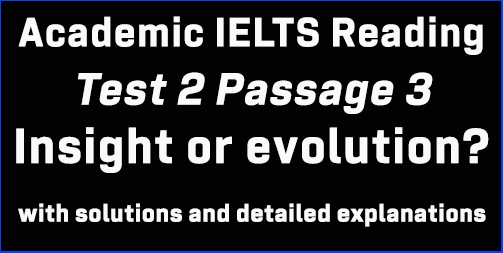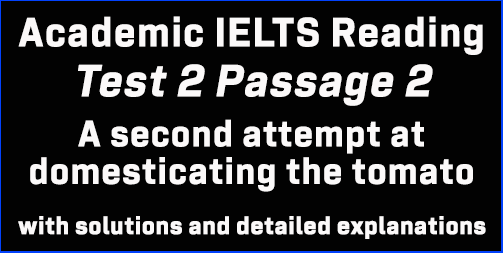IELTS Academic Reading: Cambridge 7, Test 2: Reading Passage 2; The True Cost of Food; with top solutions and step-by step detailed explanations
This IELTS Reading post focuses on all the solutions for IELTS Cambridge 7 Test 2 Reading Passage 2, which is entitled ‘The True Cost of Food’. This is a targeted post for IELTS candidates who have great problems in finding answers for the Academic Reading module. This post can guide you the best to comprehend each Reading answer without facing much difficulty. Tracing IELTS Reading answers is a gradual process and I sincerely hope this post can help you in your IELTS Reading preparation.
IELTS Cambridge 7 Test 2: AC Reading Module
Reading Passage 2:
The headline of the passage: The True Cost of Food
Questions 14-17 (Identifying information):
[This question asks you to find information from the passage and write the number of the paragraph (A, B, C or D … .. ) in the answer sheet. Now, if the question is given in the very first part of the question set, I’d request you not to answer them. It’s mainly because this question will not follow any sequence, and so it will surely kill your time. Rather, you should answer all the other questions first. And just like List of Headings, only read the first two lines or last two lines of the expected paragraph initially. If you find the answers, you need not read the middle part. If you don’t find answers yet, you can skim the middle part of the paragraph. Keywords will be a useful matter here.]
Question 14: a cost involved in purifying domestic water
Keywords for this question: cost, purifying, domestic water,
Here, ‘cost’ means the amount of money spent on something.
We can use a short technique here. Let’s find out some symbols such as $, £ or € that indicate ‘cost’.
If you scan the passage for these symbols, we can find out that paragraphs D and E contain the ‘$’ symbol. Now, we need to scan the information around the symbol and look for something that indicates ‘the purification of water’.
In paragraph E, take a look at these lines, “ . . . . £23m for the removal of the bug Cryptosporidium from drinking water by water companies; . . . .”
Here, the removal of the bug . . .. from drinking water = purifying domestic water,
So, the answer is: E
Question 15: the stages in the development of the farming industry
Keywords for this question: stages, development, farming industry,
The keyword here is ‘the stages’ which means we need to look for some linkers indicating ‘process’ such as First, Then, Next, After that etc.
In paragraph B, the writer says at the beginning, “First mechanisation, then mass use of chemical fertilisers and pesticides, then monocultures, then battery rearing of livestock, and now genetic engineering – the onward march of intensive farming has seemed unstoppable in the last half-century, as the yields of produce have soared.”
The linkers indicate that the development of the farming industry started with mechanisation; then came the mass use of chemical fertilisers and pesticides and after that came monocultures. Next, it was battery rearing of livestock and presently it is genetic engineering.
So, the answer is: B
Question 16: the term used to describe hidden costs
Keywords for this question: term, describe, hidden costs,
Here, we need to look for the term – word or phrase – that describes ‘hidden cost’.
Looking at paragraph C, we can find out the following sentences, “.. . . That is mainly because the costs of all this damage are what economists refer to as externalities: they are outside the main transaction …. . .”
Therefore, we can see that the term ‘externalities’ means the extra cost (they are outside the main transaction).
So, the answer is: C
Question 17: one effect of chemicals on water sources
Keywords for this question: effect, chemicals, water sources,
In paragraph B, take a look at the last lines, “. .. … Natural soil fertility is dropping in many areas because of continuous industrial fertiliser and pesticide use, while the growth of algae is increasing in lakes because of the fertiliser run-off.”
Here, industrial fertiliser and pesticide = chemicals, the growth of algae is increasing = one effect,
So, the answer is: B
Questions 18-21 (YES, NO, NOT GIVEN)
[In this type of question, candidates are asked to find out whether:
The statement in the question matches the claim of the writer in the text- YES
The statement in the question contradicts the claim of the writer in the text- NO
The statement in the question has no clear connection with the account in the text- NOT GIVEN
[TIPS: For this type of question, you can divide each statement into three independent pieces and make your way through with the answer.]
Question 18: Several species of wildlife in the British countryside are declining.
Keywords for this question: several species, wildlife, British countryside, declining,
We can find the answer in paragraph B, take a close look at lines 4-7, “ . .. . But the damage it has caused has been colossal. In Britain, for example, many of our best-loved farmland birds, such as the skylark, the grey partridge, the lapwing and the corn bunting, have vanished from huge stretches of countryside, as have even more wild flowers and insects.
Here, have vanished = declining,
So, the answer is: YES
Question 19: The taste of food has deteriorated in recent years.
Keywords for this question: taste of food, deteriorated, recent years,
There is a reference to the cost of food in recent years is found in paragraph A. However, no reference to the quality of food, especially the taste is found in this passage.
So, the answer is: NOT GIVEN
Question 20: The financial costs of environmental damage are widely recognised.
Keywords for this question: financial costs, environmental damage, widely recognised,
In paragraph C, in line no. 2, the author talks about the financial costs or environmental damage, “. . .. That is mainly because the costs of all this damage . . . .”
Then, in lines 5-6, the writer says, “ . .. . . To many, the costs may not even appear to be financial at all, but merely aesthetic- a terrible shame, but nothing to do with money.”
These lines suggest that many people may not recognise these costs as financial at all.
So, the answer is: NO
Question 21: One of the costs calculated by Professor Pretty was illness caused by food.
Keywords for this question: one, costs calculated, Professor Pretty, illness, caused by food,
Paragraph E gives the detailed costs calculated by Professor Pretty. In line no. 6, the author mentions one of the calculations, “… £169m from food poisoning; … . .”
Here, food poisoning = illness caused by food,
So, the answer is: YES
Questions 22-26 (Completing summary with NO MORE THAN THREE WORDS)
[In this type of question, candidates are asked to complete a summary using information from the passage with NO MORE THAN THREE WORDS. Keywords and synonyms are important to find answers correctly. Generally, this type of question maintains a sequence. Find the keywords in the passage and you are most likely to find the answers.]
Question 22: Professor Pretty concludes that our __________ are higher than most people realise, because we make three different types of payment.
Keywords for this question: Professor Pretty, concludes, higher than, most people realise, because, make three, types, payment,
Let’s have a look at paragraph E. Here the writer says in lines 6-11, “Professor Pretty draws a simple but memorable conclusion from all this: our food bills are actually threefold. We are paying for our supposedly cheaper food in three separate ways: once over the counter, secondly through our taxes which provide the enormous subsidies propping up modern intensive farming, and thirdly to clean up the mess that modern farming leaves behind.”
Here, higher corresponds to threefold = three times as much/ triple, conclude = draw a conclusion, three different types= three separate ways, make payment = paying for, over the counter = in the shops,
So, the answer is: food bills / food costs
Question 23: He feels it is realistic to suggest that Britain should reduce its reliance on _________.
Keywords for this question: feels, realistic, suggest, Britain, should reduce, reliance on,
In paragraph F, the writer states in lines 1-4, “Breaking away from industrial agriculture as the solution to hunger may be very hard for some countries, but in Britain, where the immediate need to supply food is less urgent, and the costs and the damage of intensive farming have been clearly seen, it may be more feasible.”
Here,
These lines indicate that Professor Pretty shows the attitude that breaking away from industrial agriculture is possible (realistic) though it may be very hard. This is because the need for food in Britain is not so urgent. However, the damage done by intensive farming has been more apparent.
So, the answer is: (modern) intensive farming / agriculture
Question 24: Although most farmers would be unable to adapt to __________.
Keywords for this question: Although, most farmers, unable to adapt,
Let’s have a look at paragraph G where the writer says in lines 2-3, “.. .. . Professor Pretty feels that organic farming would be too big a jump in thinking and in practices for many farmers.”
Here, would be too big a jump in thinking and in practices = would be unable to adapt
So, the answer is: organic farming
Question 25: Professor Pretty wants the government to initiate change by establishing what he refers to as a ___________.
Keywords for this question: Professor Pretty, wants, government, initiate change, establishing, refers to as,
Again in paragraph G, the author states in lines 4-7, “.. . He is recommending the immediate introduction of a ‘Greener Food Standard’, which would push the market towards more sustainable environmental practices than the current norm, while not requiring the full commitment to organic production.”
Therefore, the lines indicate that Professor Pretty wants the government to start making change by introducing (establishing) Greener Food Standard.
So, the answer is: Greener Food Standard
Question 26: He feels this would help to change the attitudes of both __________ and ___________.
Keywords for this question: feels, would help, change, attitudes, both,
In paragraph G, the writer says in the last lines, “… .. . It could go a long way, he says, to shifting consumers as well as farmers towards a more sustainable system of agriculture.”
Here, shifting = change, a more sustainable system of agriculture = the attitudes… changed,
So, the answer is: (in either order)
farmers,
consumers,
Click here for solutions to Cambridge 7 Test 2 Reading Passage 1
Click here for solutions to Cambridge 7 Test 2 Reading Passage 3




Very helpful to me. Thank you so much.
Is “industrial farming” acceptable for question 23 too?
Honestly speaking you really help me with your way of explaining your answers I feel like having a tutor Beside me